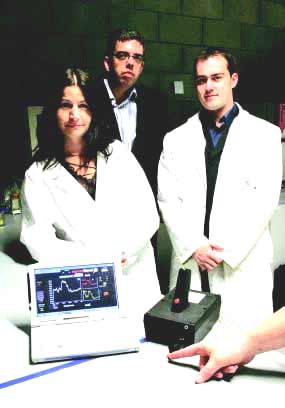| 2006 |

|
YEAR BOOK |
University of Limerick
|
MSSI scientists develop a novel screening protocol for bone fragility
|

Human bone is made of a protein called collagen, that provides flexibility, and a mineral called hydro-xyapatite, that provides hardness. Osteo-porosis causes depletion of both the collagen and the hydroxyapatite resulting in an increased likelihood of fracture. In Ireland, bone fractures cost the exchequer around �12m pa excluding costs relating to physio-therapy, drugs and social welfare. In the USA it is estimated that osteoporosis care costs US$3b pa.
The current method of determining whether someone is suffering from osteoporosis is to expose their body to low level x-rays called DEXA (dual x-ray absorptiometry) scans which measure bone mineral density (BMD). This procedure, which can only take place in hospitals, is time consuming and requires trained staff. Additionally, studies have shown that low BMD does not directly relate to fracture risk. Thus, while the density of bone mineral is the standard by which osteoporosis is currently diagnosed, it is unable to detect bone fragility related to protein deficiencies.

The Bone Quality Test(TM) (BQT) can detect the onset of bone fragility by measuring the disulphide bond content of the fingernail using Raman spectroscopy; these properties can be used as an indicator for bone quality as both nail keratin and bone collagen require sulphation and disulphide bond formation for structural integrity.
Dr Towler and Crescent Diagnostics are currently working with pharmaceutical companies to exploit this new test to monitor drug and treatment protocols.
Preliminary results from this work are available in the paper entitled 'The Use of Fingernail as a Means of Assessing Bone Health; A Pilot Study.' I. Pillay, D. Lyons, M. J. German, N. S. Lawson, H. M. Pollock, J. Saunders, S. Chowdhury, P. Moran & M. R. Towler; J. Women's Health, 2005, 14/4, pp. 339-344.
Contact: Dr Mark Towler,
MSSI, University of Limerick.
Tel: +353-61-213127;
E-mail: [email protected] ,